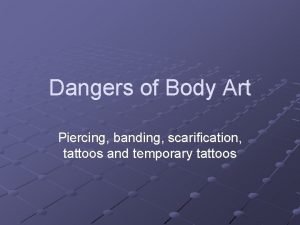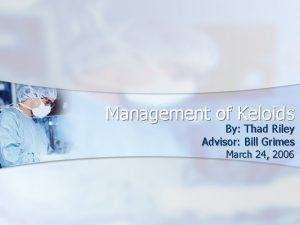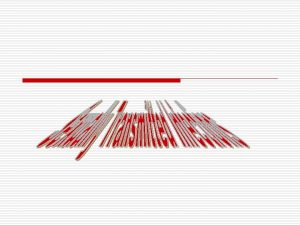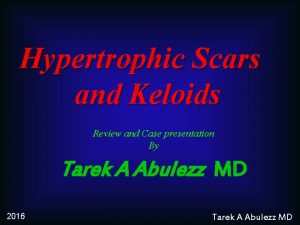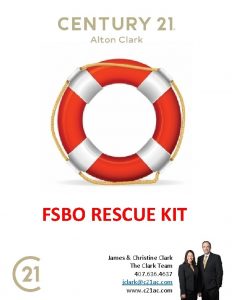The Management of Keloids Teonia Clark What is



















- Slides: 19

The Management of Keloids Teonia Clark

What is a keloid • A keloid is a growth of extra scar tissue where the skin has healed after an injury • Extends beyond original bounds • Raised and firm • Rarely occur distal to wrist or knee • Has a preference to the ear, sternum, deltoid and mandible

What causes keloids? • Trauma • Scarring after surgery • Burns • Inflammation • Foreign- body reactions • Endocrine dysfunction

Chest Keloid After Open Heart Surgery Radiation is not the treatment of choice for chest because of the chance of malignancies. Thyroid and breast cancer have been reported to develop after radiation for keloids. Tx devices are not stable on the chest

Chest Keloid After Burn

Who gets keloids? Anyone can get them but people of darker skin are more prone. • • African Americans, Hispanics, and Asians are more likely to keloid than Caucasians • More common in ppl under 30. Risk peaking between 10 -20 and in pts w/ elevated hormone levels

Imaging • X-ray • Ultrasound • CT • MRI- T 1 • MRI- T 2 • PET • Scrintigraphy

What types of treatment are available? Radiation Steroid Injection Surgery cryosurgery 5 -fu interferon pressure devices

Keloid Case #1 • 22 Yr old male presents with keloid of the left buttock and an umbilical hypertrophy • Hx of Lipoma • Patient was treated with several attempts of surgical removal

Radiation Treatment Before Radiation After Radiation

Keloid Case #2 34 -year old female presents with recurrent keloid behind her left ear. Patient was treated in 5 fx’s to a total of 1500 c. Gy, 300 c. Gy/day with 6 Me. V and 1 cm bolus. A 6 x 6 cone was used. She has a hx of endometrial cancer and a family hx of ovarian cancer from her mother. The pt was positioned on her right side w/ a wedge behind her back for support and strapped to the PSA (for fear of heights). Her ear was taped and the bolus was placed on top.

Superficial Brachytherapy After Keloidectomy • 21 • 36 patients studied from 4/08 -4/09 histologically confirmed keloids were treated with HDR-SB • All pt’s had a keliodectomy • All patients of Asian ethnicity (18 -69) • Median age 41 • 16 female and 5 male

• • The keloids were located on the anterior chest wall, scapular, lower jaw, suprapubic area and other areas Ir-192 was used 20 Gy in 4 fx/day was used for the suprapubic, lower jaw, scapular and chest wall 15 Gy in 3 fx/day was used for all other lesions Only 2 pt had recurrance Of these 2 pt’s 1 had dysraphia No other patients had reactions other than erythema

Managing Keloids and Hypertrophic Scars • Keloids can be developed either by family heredity or high risk trauma (i. e. surgery, ear piercing, burns). • They can be prevented if anticipated with the use of injection, silicone or taping • Once they are established they are difficult to and have a high recurrence rate.

Mangement cont… Before a procedure ask the patient if they have had problems with scarring in the past. • Have an informed consent discussing the risk and potential to scar or keloid. • Use pressure earrings for pierced ears • Top choices for tx are: • • Presssure tx • Steroid inj • Silicone sheeting

Chest Keloid After Acne Scar

Summary Keloids are either hereditary or obtained through trauma. Keloids can be managed but once established they are more difficult to treat. Radiation is used but not as the first treatment choice Pressure tx, Steroid inj and silicone tx are preferred

All of the following are the treatment of choice for keloids except: A. B. C. D. E. Excision alone Excision with adjuvant therapy (e. g. radiation) Pressure treatment Intralesional injection of steroids Topical Cream

All of the following statements about keloids are true except? A. B. C. D. Keloids do not regress spontaneously Keloids extend beyond the boundaries of the original wound Keloids or hypertrophic scars are best managed by excision and careful reapproximation of the wound Keloid tissue contains an abnormally large amount of collagen.
 Keloids tattoo
Keloids tattoo Clark and clark marketing functions
Clark and clark marketing functions Hát kết hợp bộ gõ cơ thể
Hát kết hợp bộ gõ cơ thể Slidetodoc
Slidetodoc Bổ thể
Bổ thể Tỉ lệ cơ thể trẻ em
Tỉ lệ cơ thể trẻ em Gấu đi như thế nào
Gấu đi như thế nào Tư thế worm breton là gì
Tư thế worm breton là gì Chúa sống lại
Chúa sống lại Kể tên các môn thể thao
Kể tên các môn thể thao Thế nào là hệ số cao nhất
Thế nào là hệ số cao nhất Các châu lục và đại dương trên thế giới
Các châu lục và đại dương trên thế giới Công thức tính thế năng
Công thức tính thế năng Trời xanh đây là của chúng ta thể thơ
Trời xanh đây là của chúng ta thể thơ Cách giải mật thư tọa độ
Cách giải mật thư tọa độ 101012 bằng
101012 bằng Phản ứng thế ankan
Phản ứng thế ankan Các châu lục và đại dương trên thế giới
Các châu lục và đại dương trên thế giới Thể thơ truyền thống
Thể thơ truyền thống Quá trình desamine hóa có thể tạo ra
Quá trình desamine hóa có thể tạo ra
